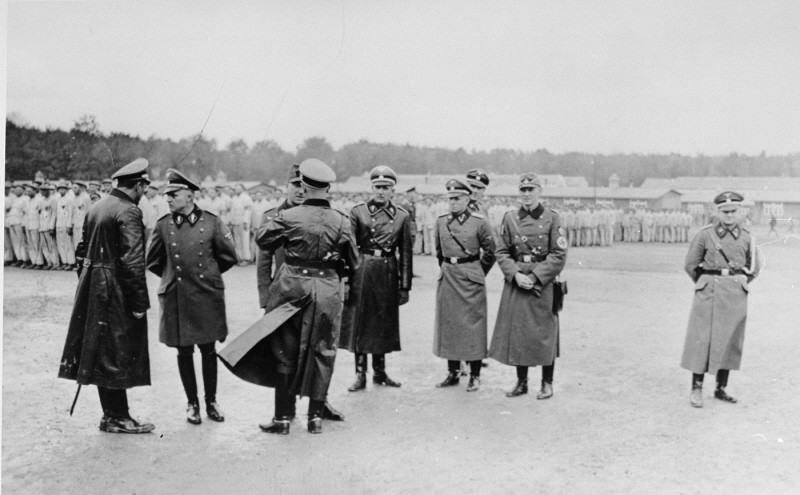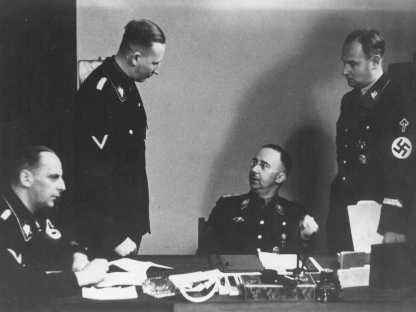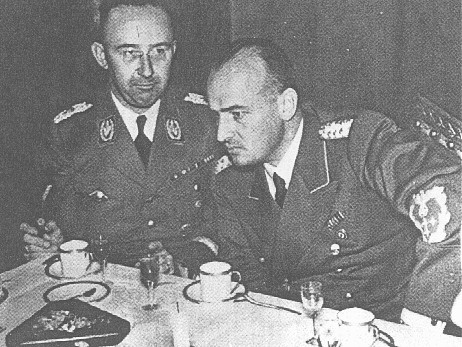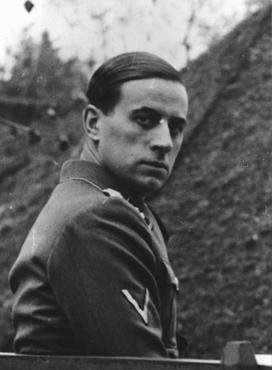
Perpetrators
The SS, a Nazi paramilitary led by Heinrich Himmler, played the central role in carrying out the “Final Solution,” the plan to murder the Jews of Europe. But, the SS did not work alone. They relied upon other German institutions and professionals.
Key Facts
-
1
German SS and police leaders under Heinrich Himmler were some of the most notorious and powerful perpetrators of the “Final Solution.” They oversaw killing squads and killing centers.
-
2
SS officer Adolf Eichmann of the Reich Security Main Office was in charge of organizing the mass deportations of Jews to their deaths in German-occupied eastern Europe. He relied on the cooperation of the German State Railways, German Foreign Office, and others.
-
3
Other institutions and individuals who facilitated the genocide included: the Wehrmacht (the German armed forces); the German central bank; German physicians and other healthcare professionals; and German industrialists and private industrial concerns, such as I.G. Farben and Krupp.
The SS

The members of the SS, the elite guard of the Nazi regime, were key players in the "Final Solution," the plan to murder the Jews of Europe. The head of the SS, Heinrich Himmler, and his subordinates, Reinhard Heydrich, Kurt Daluege, and others, established the SS and police state under Adolf Hitler and led the efforts to carry out the regime’s ideological agenda. Toward that end, the SS perpetrated countless acts of mass murder.
SS and Police Commanders such as Friedrich Jeckeln and Hans-Adolf Prützmann and Einsatzgruppen (mobile killing unit) commanders such as Arthur Nebe, Karl Jäger, Walter Stahlecker, Emil Rasch, and Otto Ohlendorf directed the ruthless and systematic shooting of men, women, and children in the killing fields of the occupied Soviet Union. In occupied Poland, SS men including Odilo Globocnik, Wilhelm Koppe, Christian Wirth, Franz Stangl, Oswald Pohl, Richard Glücks, and Rudolf Höss established killing centers equipped with gas chambers to facilitate assembly line mass murder.
Other Key Players
Murder on such a colossal scale could not be carried out by the SS alone, however. The implementation of the “Final Solution” required cooperation from and participation of the military bureaucracy and the German civilian authorities.

Mass deportation operations required the cooperation of Adolf Eichmann of the Reich Security Main Office work with Albert Ganzenmueller of the German State Railways and Joachim von Ribbentrop of the German Foreign Office. SS killing or deportation operations in occupied Poland and the occupied Soviet Union required the cooperation of civilian occupation authorities under Hans Frank, Erich Koch, Hinrich Lohse, and others.
The Wehrmacht (German armed forces), under the direction of Wilhelm Keitel and Alfred Jodl, provided the Einsatzgruppen with transportation and supplies. On the orders of Army commanders such as Walter von Reichenau and Erich Manstein, the Wehrmacht also participated in the mass murder of Jews and other Soviet civilians and especially of Soviet prisoners of war.
The Reichsbank, the German central bank headed by Walther Funk, served as a depository for stolen currency and gold and helped to finance the SS killing operations.

German physicians and other healthcare professionals implemented the Euthanasia Program, murdering tens of thousands of people with mental and physical disabilities living in institutional settings. Other physicians conducted unethical and cruel medical experiments, and determined in “selections” at killing centers which prisoners should live and which should die.
German industrialists such as Gustav Krupp and private German industrial concerns such as I.G. Farben and Krupp used laborers from the forced-labor programs directed by Albert Speer and Fritz Sauckel. A subsidiary of I.G. Farben provided the Zyklon B gas used to kill in the gas chambers.
Critical Thinking Questions
Explore how challenges to ethical behavior and leadership played out in the context of the Holocaust. How do these challenges confront us today?
In what ways did the SS coordinate the activities of German and foreign police agencies to promote the systematic persecution and mass murder of Europe's Jews?
Consider all of the occupations, staff, and workers who participated in the movement of millions of people on the railroad system. What pressures and motivations might have influenced their choices and actions?
Across Europe, the Nazis found countless willing helpers who collaborated or were complicit in their crimes. What motives and pressures led so many individuals to persecute, to murder, or to abandon their fellow human beings?

